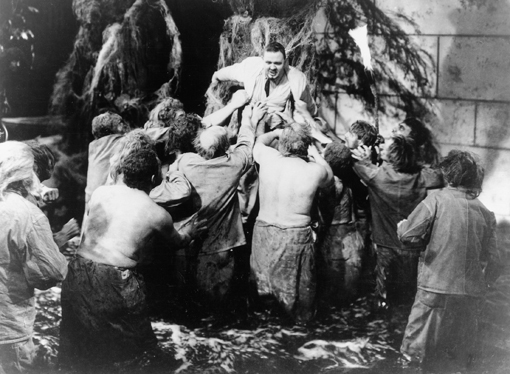2012. GB. DVD + Blu-ray. Eureka (Masters of Cinema series). 71 minutes + extras. £19.99
About the Author: Dr Andrew Bartlett, Cesagen, Cardiff University, is a research assistant working on the Genomics and Psychiatry research project, jointly funded by Cesagen and the Wales Gene Park. E-mail: bartletta@cardiff.ac.uk www.cardiffsciscreen.blogspot.com
Captain Donahue: What kind of a place did you say this was, Doc? Dr Moreau: I didn’t say. It’s an experimental station of a sort for bio-anthropological research.
The Island of Lost Souls (1932) is an adaptation of H.G. Wells’ novel, The Island of Doctor Moreau, in which the reclusive scientist Dr Moreau conducts experiments on a South Sea island in an attempt to make human-like creatures from animals. One of the first ‘talkies’ to address ‘scientific hubris’, it is also an influential entry into the early golden age of Hollywood horror, being made shortly after the more famous Frankenstein and Dracula (Bela Lugosi plays an important, if minor role in the film as the ‘Sayer of the Law’). However, The Island of Lost Souls is also science fiction in the most literal sense – it addresses the practice and products of science and their social and ethical possibilities.
The film makes several changes from the book. Several of these are largely superficial; the ‘hero’, for example, changes from Prendrick, an Englishman, into Parker (Richard Arlen), an American. The most dramatic change, however, is in the addition of romance subplot. Dr Moreau’s (Charles Laughton) latest experimental subject is Lota (Kathleen Burke), a woman-like creature derived from a panther. Lota, we learn, is Moreau’s test of his techniques. Moreau explains, 'I wanted to prove how completely she was a woman. Whether she was capable of loving, mating, and having children.'
While the romance was probably added with an eye toward giving the film the kind of narrative that cinema audiences of the time expected, it has the effect of giving the film an extra dimension by it can be used to illustrate broader themes. At its core, the film is about disgust, and the way disgust is used to distinguish right from wrong, human from animal. When Parker confronts Moreau, the grounds of his objection are brought to the fore:
Parker: An animal with a woman’s emotions, a woman’s heartbreak, a woman’s suffering. Well that’s criminal! Moreau: You’re an amazingly unscientific young man. Parker: I would have overlooked those others. I would have shown you that much consideration. But not now. Now I’ll expose you to the world for what you really are, Moreau!
Dr Moreau is right. Parker is an amazingly unscientific young man. Moreau has been driven from England due to societal disgust with his vivisectionist experiments – his ‘bio-anthropological’ techniques have developed to the point of using plastic surgery, blood transfusions, gland extracts, and ray baths to transform animals into creatures of human-like form and intellect. Parker represents that society – particularly its disgust – arrived at the shore of Moreau’s South Sea island. The horde of beast-men living in primitive conditions in the jungle unsettles Parker, the unanaesthetized ‘bio-anthropological’ vivisection unnerves him, but none of this is enough to prompt him into action. It requires a crossing of boundaries – Lota is both less bestial, more human in form than the beast-men, but she also lives inside Dr Moreau’s compound, and is in the process of being civilized. Parker’s objections to Moreau’s research are grounded neither in science, nor any deep consideration of morality or ethics, but in disgust.
The Island of Lost Souls could be used to illustrate and prompt discussion on the regulation of scientific research, as well as ‘scientific hubris’ and ‘playing god’ (literally, as Dr Moreau has established himself as both creator and law-giver of the beast-men). As old as the film is – and students should be reminded that it is one of the foundational examples of the genre – the issues it raises have contemporary relevance. While scientists wishing to escape restrictive regulatory regimes do not need to obtain private islands in the South Seas, clinics offering unproven stem cell therapies thrive outside the tight controls imposed in the US and Europe. The boundary between human and animal, and between species in general, and objections to anything that might breach these boundaries, are live debates. Hybrid embryos, genetic modification, xenotransplantation all draw reactions not too dissimilar from what we might expect from Parker. Scientific and medical misconduct will always be with us, as will lurid representations of the mad (or bad) scientist – in this case Charles Laughton provides a performance of such magnificently exaggeratedly sinister louche that to contemporary eyes it verges on the comedic.
Dr Andrew Bartlett www.cardiffsciscreen.blogspot.com/
